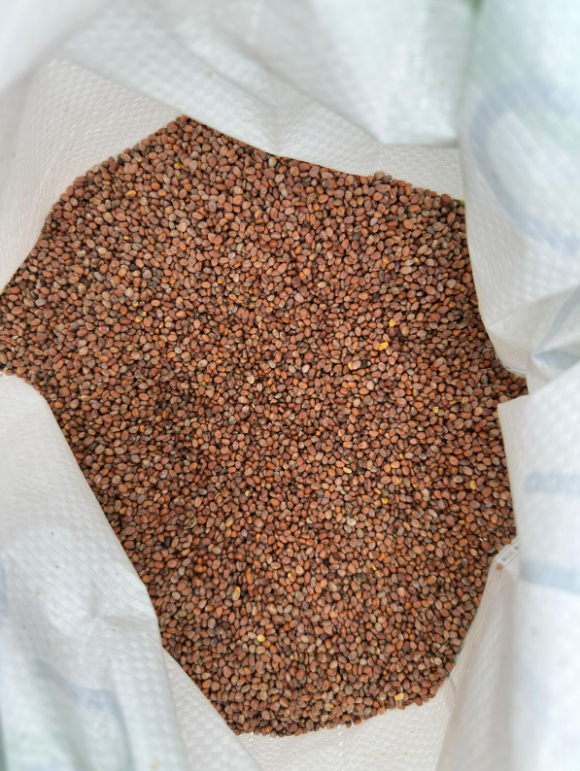Establishment
Although many principles are the same as cash crops, cover crops require a unique approach to minimise variation in establishment.
It is often best to start simple, especially when cover cropping for the first time. For example, cheaper mixes established with existing on-farm machinery will minimise risks, should establishment be disappointing. Devote more time and resource to cover crops in later seasons as experience builds to inform choices.
Sowing method
Specialist machinery is not required to establish cover crops. Standard farm equipment can be used to drill or broadcast them.
Where an applicator tank has been used to handle herbicides, ensure it is cleaned thoroughly before use.
As seeds of different sizes and weights have different ballistic properties, the approach taken needs to avoid striping in the field.
Some applicators provide a more even distribution of different seed sizes/weights when broadcasting. For example, heavier seeds tend to broadcast further. Machinery selection can help. For example, by using an Avadex spreader instead of a standard spinning disk spreader.
Not all cover crop species are suited to broadcasting. Increase seed rates to compensate for expected lower germination and increased seed predation when seeds are surface sown.
When mixing cover crop seed in a single hopper, minimise gravitational separation. This is where heavier seed sinks to the bottom of a hopper, especially during transit, even if seeds were initially well mixed. Adding seed mixes to the hopper in smaller, well mixed batches, as opposed to a single bulk load, can help.
(Image: Yorkshire Agricultural Society)

Sowing rates
Recommended standard sowing rates for commercial ‘off the shelf’ straights and mixes are often available online or from seed suppliers.
If you have a bespoke mix, tailored to your needs, you can use the recommended seed rate for each individual species (sown as straights) and a simple formula to estimate the rate for each species in a mix.
Simply divide the individual species sowing rate by the number of species in the mix and use a seed rate calculator.
(Image: AHDB)

Sowing times
Sow cover crops when conditions are suitable for good establishment and subsequent plant growth.
In the UK, this typically means sowing cover crops as soon as possible after harvest in summer and autumn. This provides the warmth and daylength needed for germination and establishment, and maximises growth before temperatures fall.
Some cover crop species suit later sowing better. Typically, earlier sowing improves choice and performance. It even allows the inclusion of some C4 species with beneficial traits, such as improved drought tolerance.
Where early establishment is not possible, for example in more northern regions with later harvests, sowing into standing crops pre-harvest may help to extend cover crop growing periods, and can be assisted through machinery solutions.
When setting sowing times, time to maturity and flowering should also be considered.
Some cover crop species will develop biomass and flower rapidly after sowing (e.g. buckwheat and mustards). Others will take longer (e.g. phacelia and vetches). In general, the former may perform better if sowing is delayed, allowing more rapid accumulation of biomass in a shorter timeframe.
(Image: AHDB)

Sowing depths
Each cover crop species will have its own optimum sowing depth, which are detailed on the species selection page.
A relatively shallow drilling depth is required for most cover crops species. A value of 0 mm indicates suitability for broadcasting on the soil surface.
On relatively heavy soils, using a shallow (80 mm) tilth-creating tillage when establishing cover crops can reduce problems after cover crop termination in the following spring crop with drill slot opening.
Problems with variable seed depth requirements are most likely to arise with diverse cover crop seed mixes. However, machinery solutions can help to establish mixes where individual seed depth recommendations vary. For example, by broadcasting surface-sown seed from the front of the tractor while drilling seeds at depth at the back, or by using a combi-drill that can place seed at varying depths from independent hoppers.
(Image: Direct Drill, Newcastle University)

However cover crops are sown, rolling is recommended to improve seed-to-soil contact, improve moisture retention, and minimise losses.
Good residue management is also important, with cultivation to assist establishment (when required) by improving seed-to-soil contact and providing a clean seed bed (to minimise competition from weeds).
Cover crops are also susceptible to pests and diseases, with slugs particularly significant. If required, slug control can be actioned as in any standard crop.
As cover crops are often grown to stabilise and take up nutrients left over from previous crops, fertilisers are rarely needed. These should only be considered to meet specific objectives, such as biomass generation to build soil organic matter. In these cases, adhere to any general and local rules on application type and timing. For specific nutrient management recommendations, consider contacting a specialist seed supplier.
The most commonly used online resources for cover cropping have been reviewed by a team at Newcastle University, with the following recommended for this topic.

